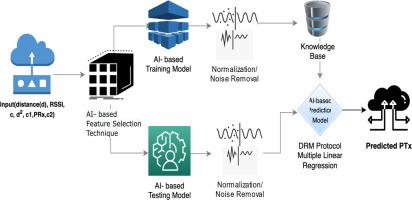The AI-DRM protocol to enhance the lifetime of wireless sensor network
IF 1.9
Q2 MULTIDISCIPLINARY SCIENCES
引用次数: 0
Abstract
Energy is a major research challenge in wireless sensor networks since it is placed in an area that is inaccessible to humans. In the current study, nodes send data to their neighboring nodes at any distance using the same energy level. Smaller distances require less energy to transmit to adjacent nodes, creating a strong research gap. High-distance transmissions require more energy. The node must tailor its transmission energy to distance, not fixed energy. The best transmission power for communication is determined via the neural network-based machine learning technique, which is based on the propagation model and network properties, such as the node density, residual energy, and energy harvesting rate. In this work, sensor nodes transmit information to their neighboring nodes via the multiple linear regression model for dynamic radio tuning with the FRIIS propagation model, and the simulation records the node's energy consumption. Compared with the four recent best current methods that increase the W.S.N. lifetime, the proposed protocol is better and uses less power. The proposed AI-DRM protocol has sufficient residual energy to transmit the packet until 1403 rounds, which is higher than those of two recent energy-efficient protocols, the ARORA and the EACHS-B2SPNN protocols.
- 1.The AI-based dynamic transmission power protocol tunes the sensor nodes using a propagation model.
- 2.Prediction of lifetime of WSN
- 3.Effective utilization of all sensor nodes1

采用AI-DRM协议提高无线传感器网络的寿命
能源是无线传感器网络的一个主要研究挑战,因为它被放置在人类无法进入的区域。在目前的研究中,节点使用相同的能级向任意距离的相邻节点发送数据。更小的距离需要更少的能量传输到相邻的节点,这就造成了一个很大的研究空白。远距离传输需要更多的能量。节点必须根据距离调整传输能量,而不是固定能量。通过基于神经网络的机器学习技术确定通信的最佳传输功率,该技术基于传播模型和网络特性,如节点密度、剩余能量和能量收集率。在这项工作中,传感器节点通过多元线性回归模型将信息传递给相邻节点,并使用FRIIS传播模型进行动态无线电调谐,仿真记录节点的能量消耗。与目前四种提高无线网络生存期的方法相比,该协议性能更好,功耗更低。提出的AI-DRM协议有足够的剩余能量将数据包传输到1403轮,这比最近的两个节能协议ARORA和EACHS-B2SPNN协议的剩余能量要高。基于人工智能的动态传输功率协议采用传播模型对传感器节点进行调谐。WSN3寿命预测。有效利用所有传感器节点1
本文章由计算机程序翻译,如有差异,请以英文原文为准。
求助全文
约1分钟内获得全文
求助全文
来源期刊

MethodsX
Health Professions-Medical Laboratory Technology
CiteScore
3.60
自引率
5.30%
发文量
314
审稿时长
7 weeks
期刊介绍:
 求助内容:
求助内容: 应助结果提醒方式:
应助结果提醒方式:


